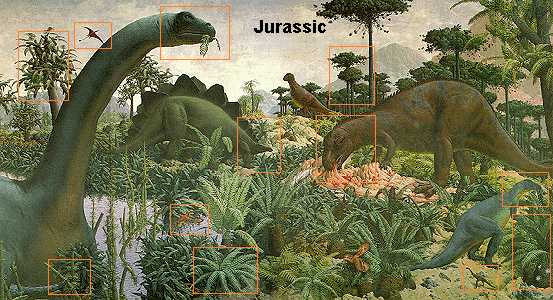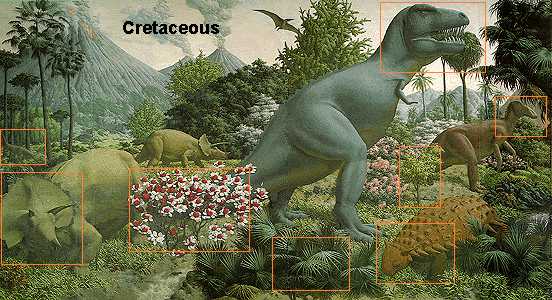The Age Of The Reptiles

Jurassic Period: High Noon of the Dinosaurs
(Between 144 to 208 million years ago)
Continental conditions of the Triassic Period continued into the Jurassic interval in many places around the world. Climates continued to be near-tropical, and dinosaurian evolution introduced an impressive roster of cast members -- most new and very different from the smaller and less famous company that preceded them -- ranging from the huge sauropods to the tiny birdlike predators. Among the saurischian dinosaurs abundant during Jurassic times were the carnivorous or theropod dinosaurs such as Allosaurus or Antrodemus and the very small chicken-sized predator Compsognathus. Other saurischians were the well-known sauropods, including the plant-eating and possibly swamp-dwelling Brontosaurus or Apatosaurus, as it should be called (scientists now think that Brontosaurus and Apatosaurus were one and the same animal, but the former name remains in widespread use).
Although some changes are apparent in the vegetation of the Jurassic, especially a diminution in the importance of seed ferns in Southern Hemisphere areas not shown on the mural, for the most part the period represents a continuation of lines already well established in Triassic times. Some cycadeoids, such as Williamsonia, had attained the stature of moderately tall trees with crowns of divided, palmlike leaves.

Cretaceous Period: The Final Chapter
(Between 65 to 144 million years ago)
This last chapter of the Age of Reptiles began quietly enough with most of the land areas of the world steaming under near-tropical conditions and much of the country lying at only moderate elevations or quite close to sea level. By the close of the Cretaceous interval, however, mountain building once again dominated several regions of the world. Our own Rocky Mountains were pushed up during the last stages of the Cretaceous. Amid this scene of upheaval appeared a variety of dinosaurs -- nearly all of them new and all descended from the various types that had been common during the Jurassic.
The last major development in the evolution of land plants occurred with the appearance of flowering plants sometime around the beginning of the Cretaceous period. Within a span of some 5O million years, well before the dinosaurs became extinct, the flowering plants, or angiosperms, had risen to dominate the earth's flora and had changed its ecology in fundamental ways. The unique extent to which flowering plants depend upon insects, birds, and small mammals to carry their pollen and distribute their seeds has brought them into close coevolutionary relationships with these animals. As a result of the nearly infinite possibilities for variation that this provides, flowering plant species now outnumber all other land plants by twenty or thirty to one. They are also overwhelmingly dominant as the source of our food energy, both directly and as feed for the animals that we consume.
It is with this Cretaceous plant record that major discrepancies between the mural and what is currently accepted in scientific circles occur, because of important advances that have taken place in the understanding of the Cretaceous plant record over the more than forty years since the completion of The Age of Reptiles. In fact, one of the real paradoxes of the mural's final scene is that although all the animals belong to extinct forms, all the plants are members of modern genera. When the mural was completed, the prevailing scientific view, based on the then-current understanding of leaf remains, was that the Cretaceous angiosperm flora was moderately advanced and the opening chapters of its history must have transpired much earlier and in settings, such as mountain regions, where erosion would have precluded their preservation. Later research has disproved this, showing instead that Cretaceous angiosperms, especially those from the early part of the period, were truly primitive and belonged to archaic groups only distantly related to those that make up the flora of the modern world.